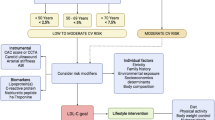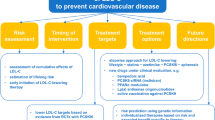Opinion statement
The treatment of lipid abnormalities generally has focused on low-density lipoprotein cholesterol (LDL-C) reduction based on extensive clinical trials and the National Cholesterol Education Program Adult Treatment Panel III guidelines. Unfortunately, it has become increasingly clear that a significant percentage of patients continue to have cardiovascular events despite being on LDL-C–lowering medications and having LDL-C levels below 100 mg/dL. Numerous epidemiologic studies have associated low high-density lipoprotein cholesterol (HDL-C) levels with increased risk of cardiovascular disease (CVD). Furthermore, recent data show that up to 55% of patients hospitalized for CVD have low HDL-C levels (<40 mg/dL) on admission, suggesting a possible target for further reducing CVD. Low HDL-C also is part of the atherogenic phenotype associated with obesity, glucose intolerance, and hypertension, termed the metabolic syndrome, and often is seen in patients with insulin resistance states. In general, the first line of therapy for increasing HDL-C in patients with levels below 40 mg/dL is lifestyle modification with smoking cessation, exercise, weight loss, and diet modifications. The pharmacologic treatment of isolated low HDL-C in patients without coronary disease is controversial but should be considered in those with a strong family history of CVD. In patients with coronary artery disease and isolated low HDL-C, statins remain the first-line therapy and should be instituted after lifestyle modifications, with the goal of increasing HDL-C above 40 mg/dL. If concomitant hypertriglyceridemia is present, a fibrate or niacin should be considered. Although statins do offer some HDL-C–raising properties, they tend to have modest effects. If treatment goals have not been achieved with either lifestyle changes or statin therapy, then the next agent of choice is niacin. Among the various HDL-C–raising therapies, niacin continues to be the most potent therapeutic option available. There are several novel HDL-C therapies in the research pipeline; however, only one class of medications is relatively close to clinical use, the cholesteryl ester transferase protein (CETP) inhibitors. Although one of the CETP inhibitors, torcetrapib, has received much negative attention from a large randomized trial showing increased mortality associated with its use, the overall class of therapeutic agents may still hold some benefit. Currently, two new CETP inhibitors without the off-target effects of torcetrapib are undergoing clinical research. Overall, the use of HDL-C–modifying agents likely will increase over the next decade.

Similar content being viewed by others
References and Recommended Reading
Papers of particular interest, published recently, have been highlighted as: • Of importance •• Of major importance
American Heart Association: 2009 Heart Disease and Stroke Statistical Update. Dallas: American Heart Association; 2009.
Wright RA, Flapan AD, McMurray J, et al.: Randomized trial of cholesterol lowering in 4,444 patients with coronary heart disease: the Scandinavian Simvastatin Survival Study (4S). Lancet 1994, 344:1383–1389.
The Long-Term Intervention with Pravastatin in Ischaemic Disease Study Group (1998). Prevention of Cardiovascular Events and Death with Pravastatin in Patients with Coronary Heart Disease and a Broad Range of Initial Cholesterol Levels. N Engl J Med 1998, 339:1349–1357.
Heart Protection Study Collaborative Group: MRC/BHF Heart Protection Study of cholesterol lowering with simvastatin in 20, 536 high-risk individuals: a randomized placebo-controlled trial. Lancet 2002, 360:7–22.
Sheperd J, Stuart CM, Ford I: Prevention of coronary heart disease with pravastatin in men with hypercholesterolemia. N Engl J Med 1995, 333:1301–1307.
Gordon T, Castelli WP, Hjortland MC, et al.: High density lipoprotein as a protective factor against heart disease: the Framingham Study. Am J Med 1977, 62:707–714.
LaRosa JC, Grundy SM, Waters DD, Treating to New Targets (TNT) Investigators, et al.: Intensive lipid lowering with atorvastatin in patients with stable coronary disease. N Engl J Med 2005, 352:1425–1435.
Barter P, Gotto AM, La Rosa JC, for the Treating to New Targets Investigators, et al.: HDL cholesterol, very low levels of LDL cholesterol, and cardiovascular events. N Engl J Med 2007, 357:1301–1310.
Birjmohun RS, Hutten BA, Kastelein JJP, et al.: Efficacy and safety of high-density lipoprotein cholesterol-increasing compounds: a meta analysis of randomized controlled trials. J Am Coll Cardiol 2005, 45:185–197.
Halbert SA, Silagy CA, Finucane P, et al.: Exercise training and blood lipids in hyperlipidemic and normolipidemic adults: a meta-analysis of randomized controlled trials. Eur J Clin Nutr 1999, 53:514–522.
Datillo AM, Kris-Etherton PM: Effects of weight reduction on blood lipids and lipoproteins: a meta-analysis. Am J Clin Nutr 1992, 53:514–522.
Rimm EB, Williams P, Fosher K, et al.: Moderate alcohol intake and lower risk of coronary heart disease: meta-analysis of effects on lipids and haemostatic factors. BMJ 1999, 319:1523–1528.
Maeda K, Noguchi Y, Fukui T: The effects of cessation from cigarette smoking on the lipid and lipoprotein profiles: a meta-analysis. Prev Med 2003, 37:283–290.
Meksawan K, Pendergast DR, Leddy JJ, et al.: Effect of low and high fat diets on nutrient intakes and selected cardiovascular risk factors in sedentary men and women. J Am Coll Nutr 2004, 23:131–140.
Parikh P, McDaniel MC, Ashen MD, et al.: Diets and cardiovascular disease: an evidence based assessment. J Am Coll Cardiol 2005, 45:1379–1387.
De Lorgeril M, Renaud S, Mamelle N, et al.: Mediterranean alpha-linolenic acid-rich diet in secondary prevention of coronary heart disease. Lancet 1994, 343(8911):1454–1459.
Bos MB, de Vries JH, Feskens EJ, et al.: Effect of a high monounsaturated fatty acids diet and a Mediterranean diet on serum lipids and insulin sensitivity in adults with mild abdominal obesity. Nutr Metab Cardiovasc Dis 2009 Aug 17 (Epub ahead of print).
Altschul R, Hoffer A, Stephen JD: Influence of nicotinic acid on serum cholesterol in man. Arch Biochem 1955, 54:558–559.
Singh IM, Shishehbor MH, Ansell BJ: High-density lipoprotein as a therapeutic target: a systematic review. JAMA 2007, 298:786–798.
Kamanna VS, Kashyap ML: Mechanism of action of niacin. Am J Cardiol 2008, 101(Suppl):20B–26B.
Capuzzi DM, Guyton JR, Morgan JM, et al.: Efficacy and safety of an extended-release niacin (Niaspan): a long-term study. Am J Cardiol 1998, 82:74U–81U.
Knopp RH, Alagona P, Davidson M, et al.: Equivalent efficacy of a time-release form of niacin (Niaspan) given once-a-night versus plain niacin in the management of hyperlipidemia. Metabolism 1998, 47(9):1097–1104.
Mckenney JM, Jones PH, Bays HE, et al.: Comparative effects on lipid levels of combination therapy with a statin and extended-release niacin or ezetimibe versus a statin alone (the COMPELL study). Atherosclerosis 2007, 197:432–437.
Zhao X, Krasuski RA, Baer J, et al.: Effects of combination lipid therapy on coronary stenosis progression and clinical cardiovascular events in coronary disease patients with metabolic syndrome: a combined analysis of the Familial Atherosclerosis Treatment Study (FATS), the HDL-Atherosclerosis Treatment Study (HATS), and the Armed Forces Regression Study (AFREGS). Am J Cardiol 2009, 104:1457–1464.
Coronary Drug Project Research Group: Clofibrate and niacin in coronary heart disease. JAMA 1975, 231:360–381.
Brown BG, Canner PL, McGovern M, et al.: Nicotinic acid. In Clinical Lipidology: A Companion to Braunwald’s Heart Disease. By Ballantyne C. Philadelphia: Elsevier; 2008:299–302.
Canner PL, Berge KG, Wenger NK, et al.: Fifteen year mortality in Coronary Drug Project patients: long-term benefit with niacin. J Am Coll Cardiol 1986, 8(6):1245–1255.
Brown G, Albers JJ, Fisher LD, et al.: Regression of coronary artery disease as a result of intensive lipid-lowering therapy in men with high levels of apolipoprotein B. N Engl J Med 1990, 323:1289–1298.
Brown BG, Zhao ZQ, Chait A, et al.: Simvastatin and niacin, antioxidant vitamins or the combination for the prevention of coronary disease. N Engl J Med 2001, 345:1583–1592.
Taylor AJ, Sullenberger LE, Lee H, et al.: Arterial biology for the investigation of the treatment effects of reducing cholesterol (ARBITER) 2: a double blind, placebo-controlled study of extended-release niacin on atherosclerosis progression in secondary prevention patients with statins. Circulation 2004, 110:3512–3517.
Taylor AJ, Vilines TC, Stanek EJ, et al.: Extended-release niacin or ezetimibe and carotid intima-media thickness. N Engl J Med 2009, 361:2114–2122.
ClinicalTrials.gov: The Atherothrombosis Intervention in Metabolic Syndrome with Low HDL/High Triglycerides and Impact on Global Health Outcomes study. Available at http://clinicaltrials.gov/ct2/show/NCT00120289?term=AIM-HIGH&rank=2. Accessed December 2009.
Paolini JF, Bays HE, Ballantyne CM, et al.: Extended-release niacin/laropiprant: reducing niacin-induced flushing to better realize the benefit of niacin in improving cardiovascular risk factors. Cardiol Clin 2008, 26:547–560.
ClinicalTrials.gov: Treatment of HDL to Reduce the Incidence of Vascular Events HPS2-Thrive [NCT00461630]. Available at http://clinicaltrials.gov/ct2/show/NCT00461630. Accessed December 2009.
Jones PH, Davidson MH, Stein EA, et al.: Comparison of the efficacy and safety of rosuvatatin versus atorvastatin, simvastatin and pravastatin across doses (STELLAR trial). Am J Cardiol 2003, 92:152–160.
Chapman JM: Fibrates in 2003: therapeutic action in atherogenic dyslipidaemia. Atherosclerosis 2003, 171:1–13.
Downs JR, Clearfield M, Weis S, et al.: Primary prevention of acute coronary events with lovastatin in men and women with average cholesterol levels: results of AFCAPS/TexCAPS. JAMA 1998, 279(20):1615–1622.
Rubins HB, Anderson JW, Elam MB, et al.: Gemfibrozil for the secondary prevention of coronary heart disease in men with low levels of high-density lipoprotein cholesterol. N Engl J Med 1999, 341(6):410–418.
Robins SJ, Collins D, Wittes JT, et al.: Relation of gemfibrozil treatment and lipid levels with major coronary events. VA-HIT: a randomized controlled trial. JAMA 2001, 285:1585–1591.
Inazu A, Brown ML, Hesler CB, et al.: Increased high-density lipoprotein levels caused by a common cholesteryl-ester transfer protein gene. N Engl J Med 1990, 323:1234–1238.
Barter PJ, Kastelein JP: Targeting cholesteryl ester transfer protein for the prevention and management of cardiovascular disease. J Am Coll Cardiol 2006, 47:492–499.
Barter PJ, Caulfield M, Eriksson M, ILLUMINATE Investigators, et al.: Effects of torcetrapib on patients at high risk for coronary events. N Engl J Med 2007, 357:2109–2122.
Nissen SE, Tardif JC, Nicholls SJ, ILLUSTRATE Investigators, et al.: Effect of torcetrapib on the progression of coronary atherosclerosis. N Engl J Med 2007, 356:1304–1316.
Nicholls SJ, Tuzcu EM, Brennan DM, et al.: Cholesteryl ester transfer protein inhibition, high-density lipoprotein raising, and progression of coronary atherosclerosis: insights from ILLUSTRATE (Investigation of Lipid Level Management Using Coronary Ultrasound to Assess Reduction of Atherosclerosis by CETP Inhibition and HDL Elevation). Circulation 2008, 118:2506–2514.
Bloomfield D, Carlson G, Sapre A, et al.: Efficacy and safety of the cholesteryl ester transfer protein inhibitor anacetrapib as monotherapy and coadministered with atorvastatin in dyslipidemic patients. Am Heart J 2009, 157:352.e2–360.e2.
Stein EA, Stroes EG, Steiner G, et al.: Safety and tolerability of dalcetrapib. Am J Cardiol 2009, 104:82–91.
Duffy D, Rader DJ: Update on strategies to increase HDL quantity and function. Nat Rev Cardiol 2009, 6:455–463.
Nissen SE, Tsunoda T, Tuzcu EM, et al.: Effect of recombinant ApoA-I Milano on coronary atherosclerosis in patients with acute coronary syndromes: a randomized controlled trial. JAMA 2003, 290:2292–2300.
Garber DW, Datta G, Chaddha M, et al.: A new synthetic class A amphipathic peptide analogue protects mice from diet-induced atherosclerosis. J Lipid Res 2001, 42:545–552.
Navab M, Anantharamaiah GM, Reddy ST, et al.: Oral D-4F causes formation of pre-B high-density lipoprotein and improves high density lipoprotein-mediated cholesterol efflux and reverse cholesterol transport from macrophages in apolipoprotein e-null mice. Circulation 2004, 109:3215–3220.
Bloedon LT, Duffy DR, Pinell-Salles P, et al.: Safety, pharmacokinetics, and pharmacodynamics of oral apoA-I mimetic peptide D-4F in high-risk cardiovascular patients. J Lipid Res 2008, 49:1344–1352.
Nissen SE, Nicholls SJ, Wolski K, et al.: Effects of a potent and selective PPARα agonist in patients with atherogenic dyslipidemia or hypercholesteromia: two randomized controlled trials. JAMA 2007, 297:1362–1373.
Bultel S, Helin L, Clavey V, et al.: Liver X receptor activation induces the uptake of cholesteryl esters from high density lipoprotein in primary human macrophages. Arterioscler Thromb Vasc Biol 2008, 28:2288–2295.
Disclosure
No potential conflicts of interest relevant to this article were reported.
Author information
Authors and Affiliations
Corresponding author
Rights and permissions
About this article
Cite this article
Bhatt, K.N., Wells, B.J., Sperling, L.S. et al. High-Density Lipoprotein Therapy: Is There Hope?. Curr Treat Options Cardio Med 12, 315–328 (2010). https://doi.org/10.1007/s11936-010-0081-x
Published:
Issue Date:
DOI: https://doi.org/10.1007/s11936-010-0081-x




